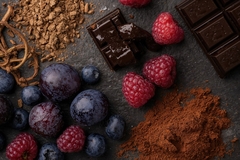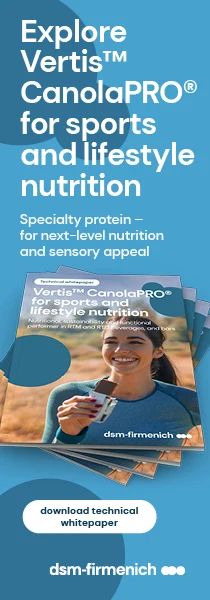Formulating with prebiotics: Industry highlights potential of fortified foods to close the fiber gap
12 Oct 2023 --- Adding prebiotic fibers to nutrition and food products is increasing globally as consumer awareness of their link to digestive health and the gut-brain axis continues to expand. Though fortified foods may help increase consumer fiber intake, manufacturers face product formulation challenges.
Nutrition Insight discusses the potential and challenges of fiber fortification with professionals from Sensus, Univar Solutions, Alland et Robert and Beneo.
“Fiber plays a positive role in maintaining health,” says Yvette Deirkauf, technical sales support specialist at Sensus. “45% of European consumers link fiber intake with digestive health. The older generations do so more often than the younger generations.”
“The ‘fiber gap’ is the difference between a person’s fiber intake and the recommended fiber intake. In the UK, the average fiber intake for adults is 18 g, just 60% of the recommended daily intake of 30 g. Sensus’ Consumer Insights Survey 2023 indicates that 84% of UK consumers do not know the daily recommended fiber intake. However, the willingness to put extra effort in eating more fiber is high (45% absolutely would).”
Sarah Gonçalves, technical business development manager of nutraceuticals at Univar Solutions, expects a significant increase in the research and incorporation of prebiotic fibers into various aspects of nutrition and health in the next two to five years.

“This is especially important due to the growing recognition of the gut-brain axis and its profound impact on metabolic processes,” Gonçalves states.
“As professionals work to address the widespread issues related to gut health on a global scale, we expect to uncover new insights that will help us better understand the intricate connections between nutrition, the gut and overall well-being.”
Enhancing fiber intake
Although fiber is pivotal in optimizing overall nutritional value, Gonçalves sees that consumers often fixate on singular nutrients.
She cautions: “It is important for individuals seeking to enhance their fiber intake to adopt a holistic approach, encompassing both insoluble and soluble fiber sources. Learning how to integrate fiber effectively and with essential nutritional elements such as lipids, micronutrients and protein is essential for achieving a well-rounded and balanced diet.”
Alland et Robert created a range of dietary fibers based on acacia gum (Image credit: Alland et Robert).Dr. Isabelle Jaouen, R&D director at Alland et Robert, adds that preparing high-fiber meals can be time-consuming. However, low fiber intake is associated with higher risks of diabetes, heart disease and other chronic diseases.
“Education is key to encouraging people to eat healthier diets and take good care of their bodies. The trend for fiber fortification is an amazing opportunity for a positive public health impact worldwide, and consumers benefit from increased fiber intake health-wise.”
She continues: “Consumers who eat products fortified with dietary fibers can enjoy the food they like while addressing their need for fiber. We know that all over the world, consumers are not getting enough fiber in their daily diets, and at the same time, more and more people are affected by digestion discomforts.”
Jaouen sees a growing awareness of pre- and probiotics that allows consumers to understand better how their bodies work and the importance of taking care of their digestive health. Moreover, she sees consumers increasingly link their health with the planet’s health, suggesting that brands “provide more and more transparency about their climate-friendly and ethical commitments.”
Popularity of prebiotics
Sensus’ Deirkauf underscores that although explicit use of gut microbiome terminology may be uncommon among consumers, increasing attention to the gut microbiome can create opportunities for ingredients like prebiotic fibers.
“Prebiotic fibers pass through the upper digestive system intact, reaching the colon where they are fermented by the gut microbiota, giving digestive health benefits. Moreover, a healthy gut microbiota is linked to supporting the immune system and even mental health.”
Gonçalves from Univar Solutions highlights that the primary trend in fiber fortification has shifted toward prebiotics due to the increasing prevalence of gastrointestinal issues combined with an increased consumer knowledge of the positive influence of prebiotics on the gut microbiota.
“Prebiotic fibers offer a multitude of benefits promoting a robust gut microbiome. Additionally, they can provide finished product functionality, such as enhancing moisture, texture and taste.”
 Chicory root fibers can boost food’s fiber content and support gut microbiota (Image credit: Beneo).She adds that prebiotics can also provide sweetness, an option for those seeking to replace or reduce sugar. “Oligofructose, inulin and resistant starch continue to be popular prebiotics for consumers and formulators alike. For consumers looking for a holistic approach to incorporate fiber into their diet, adding prebiotics is an easy solution to integrate ready-to-consume formats.”
Chicory root fibers can boost food’s fiber content and support gut microbiota (Image credit: Beneo).She adds that prebiotics can also provide sweetness, an option for those seeking to replace or reduce sugar. “Oligofructose, inulin and resistant starch continue to be popular prebiotics for consumers and formulators alike. For consumers looking for a holistic approach to incorporate fiber into their diet, adding prebiotics is an easy solution to integrate ready-to-consume formats.”
Anke Sentko, VP of regulatory affairs and nutrition communication at Beneo, also sees prebiotics and other gut-friendly foods becoming increasingly popular among consumers and shares insights from the company’s global survey on prebiotics.
“Four out of five consumers have heard of prebiotics, and over half have made the link between them and ‘supporting digestive health’ and being ‘healthy.’ Their growing popularity is mirrored in rising demand for products containing prebiotics.”
Formulating with fiber
Sentko continues that there is no “one size fits all” approach in fiber enrichment. It is always a question of the overall positioning of the food and the technological, sensory and nutritional needs.
“For manufacturers aiming for a fiber enrichment ‘plus’ approach — providing fiber with additional benefits — chicory root fibers are the preferred option. They can boost the dietary fiber content in foods and drinks and deliver another proven health benefit, such as nurturing the beneficial part of the microbiota.”
She adds that dietary fibers based on maltodextrins/starch are artificially made to be indigestible. These include synthetic fibers called soluble corn fibers, polydextrose or corn fiber. As these are not proven prebiotics, they cannot claim this fiber “plus” benefit.
Deirkauf notes that the increasing awareness regarding the fiber gap allows manufacturers to create added fiber products. However, she underscores that developing final products with a pleasing taste and texture can be challenging when enriching a recipe with fiber.
“When using insoluble fiber, physical particles are introduced often with a high-water binding capacity. This might stabilize a food product, but at (too) high levels, it can negatively affect the texture and mouthfeel. Soluble fiber does not introduce physical particles into a formulation, resulting in a pleasant texture.”
 Yvette Deirkauf, technical sales support specialist at Sensus (Image credit: Sensus).“Due to its nutritional and technological functionalities and neutral to slightly sweet taste, the soluble fibers inulin and oligofructose from the natural source of chicory make it easy for manufacturers to develop healthier, fiber-fortified foods,” continues Deirkauf.
Yvette Deirkauf, technical sales support specialist at Sensus (Image credit: Sensus).“Due to its nutritional and technological functionalities and neutral to slightly sweet taste, the soluble fibers inulin and oligofructose from the natural source of chicory make it easy for manufacturers to develop healthier, fiber-fortified foods,” continues Deirkauf.
Soluble chicory fibers can be used in various food applications, such as dairy, infant nutrition, bakery, cereals and cereal bars, beverages, confectionery and ice cream. Manufacturers can use the ingredients to increase the fiber content while reducing added sugars, fat and calories, thus improving the nutritional profile without compromising taste and texture.
Addressing taste, texture and costs
Manufacturers of fiber-fortified products experience a complex range of challenges, highlights Gonçalves, such as changes in organoleptics, increased costs and decreased shelf life.
“Regarding formulation and stability, vigilance and testing are required to ensure the quality of fiber-fortified products, as fibers tend to absorb moisture and leave a product stale.”
She explains that introducing fibers frequently triggers adjustments in texture, flavor and overall sensory attributes, demanding meticulous preservation of the desired sensory characteristics.
“Additionally, issues related to digestive tolerance may surface, as some individuals may experience discomfort such as bloating or gas, particularly if they are unaccustomed to a high-fiber diet.”
Gonçalves underscores that cost considerations become prominent due to the potential expenses of high-quality fiber ingredients. “These ingredients are susceptible to supply fluctuations driven by crop yields and weather conditions.”
As taste is critical in fiber fortification, Beneo's Sentko expects the market to grow if the flavor is not compromised.
“Consumers are also looking for provable health benefits when they make their product purchases, so scientific substantiation and health claims will continue to grow in importance. They want their food and drink products to work harder for them, so they are looking for solutions that deliver fiber fortification ‘plus’ digestive health and other benefits.”
By Jolanda van Hal
















